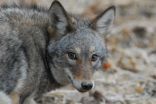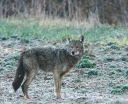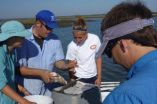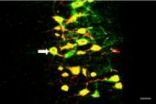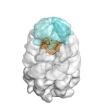Research indicates coyote predation on deer in East manageable
2014-05-09
(Press-News.org) Coyotes are a major predator of white-tailed deer across the East, especially fawns born each spring, but wildlife managers nonetheless are able to stabilize and even grow deer herds, according to researchers in Penn State's College of Agricultural Sciences.
Coyotes -- Canis latrans -- are a relatively recent arrival to eastern North America, appearing first in the region in noticeable numbers in the 1970s. They are a significant source of deer mortality and most often prey on whitetails in the earliest months of their lives. Coyotes have long inhabited the American West.
With the range expansion of coyotes eastward, and their crossbreeding with gray wolves (Canis lupus) along the way, Eastern coyotes are larger than their Western counterparts. Many people are concerned that their predation may be adversely affecting Eastern deer populations. Recently, lawmakers in Pennsylvania proposed placing a bounty on coyotes to incentivize their destruction for the sake of deer.
In response to those concerns, researchers initiated a study to look at deer and coyote populations from southeastern Canada through the mid-Atlantic region to the Southeast. Using published study data from throughout eastern North America that included fawn mortality, adult doe survival and reproductive rates -- and even the effects of severe winter weather on deer survival and predation -- researchers studied how deer populations responded to changes in predation and hunter harvest.
The research, published in the May issue of the Journal of Wildlife Management, aimed to determine whether managers can compensate for coyote predation of white-tailed deer.
"The concern is that coyotes may be changing the established population dynamics of white-tailed deer herds through increased predation on fawns," said Duane Diefenbach, adjunct professor of wildlife ecology and leader of the Pennsylvania Cooperative Fish and Wildlife Research Unit based at Penn State. "If that's true, then deer managers need to adjust how they make harvest-management decisions, because manipulating doe harvests is typically how wildlife agencies maintain, increase or decrease deer populations."
The study showed that coyote predation -- even at the highest levels reported -- is not significant enough to cause deer populations to decline if doe harvests are reduced. In fact, in most places in North America, continued doe harvest is required to stabilize deer populations.
Diefenbach said the only place in which that might not be true is the Southeast, where wildlife managers have found the highest predation rates on fawns by coyotes. In that region, an average of only one in four fawns survives to three months of age. But that is only in combination with extremely low doe-survival rates.
"However, we couldn't find any published research on adult-doe-survival rates in the Southeast, so it is possible that if doe hunting were stopped, deer populations would stabilize despite the heavy predation."
Mortality of white-tailed deer fawns is significant across the East, Diefenbach noted. Only an average of one in two survives its first three months of life, which is when most mortality occurs. Predation by coyotes, black bears and bobcats accounts for most mortality. Regardless, the number of fawns that survive generally is adequate to sustain nearly all populations.
"Besides predators, the other major source of mortality in fawns is hunting," said Diefenbach. "Thus, reduced hunting can be used to offset mortality from natural predators. Enough fawns survive all sources of mortality that we still need to harvest antlerless deer to maintain stable deer populations. There is little evidence to date that the increase in coyote predation could create a crisis that could not be solved by wildlife managers simply responding with reductions in antlerless deer harvests."
INFORMATION:
Contributing to the research were Kelly Robinson and Angela Fuller, New York Cooperative Fish and Wildlife Research Unit, Department of Natural Resources, Cornell University; Jeremy Hurst, New York Department of Environmental Conservation, Division of Fish, Wildlife, and Marine Resources; and Christopher Rosenberry, Bureau of Wildlife Management, Pennsylvania Game Commission.
ELSE PRESS RELEASES FROM THIS DATE:
Larger percentage of Texas Hispanics have enrolled in Health Insurance Marketplace plans
2014-05-09
HOUSTON – (May 9, 2014) – Texas Hispanics were more than twice as likely as whites to have enrolled in health insurance plans offered through the Affordable Care Act's Health Insurance Marketplace between September 2013 and March 2014, according to a report released today by Rice University's Baker Institute for Public Policy and the Episcopal Health Foundation.
The report also found that Hispanic adults in Texas experience more difficulty in affording health services than white adults and are three times as likely to be uninsured. In addition, Hispanic respondents ...
Role of middle predators in reef systems
2014-05-09
Northeastern University researchers at the Marine Science Center have shown that the behavior of the "middle child" in the predator-prey food chain plays a strong role in determining how the reef as a whole will fare. The new research from the team was published online on Tuesday in the journal Ecology Letters.
Northeastern ecologist David Kimbro, who claims to have watched a lot of TV growing up, particularly The Brady Bunch, compares the "middle child" behavior of oyster reefs to the show: "You could kind of get a flavor for how an episode was going to turn out based ...
Honolulu-based study reveals shorter men live longer
2014-05-09
Short height and long life have a direct connection in Japanese men, according to new research based on the Kuakini Honolulu Heart Program (HHP) and the Kuakini Honolulu-Asia Aging Study (HAAS).
"We split people into two groups – those that were 5-foot-2 and shorter, and 5-4 and taller," said Dr. Bradley Willcox, one of the investigators for the study and a Professor in the University of Hawai`i (UH) John A. Burns School of Medicine's Department of Geriatric Medicine. "The folks that were 5-2 and shorter lived the longest. The range was seen all the way across from being ...
Study strengthens link between neonicotinoids and collapse of honey bee colonies
2014-05-09
Boston, MA — Two widely used neonicotinoids—a class of insecticide—appear to significantly harm honey bee colonies over the winter, particularly during colder winters, according to a new study from Harvard School of Public Health (HSPH). The study replicated a 2012 finding from the same research group that found a link between low doses of imidacloprid and Colony Collapse Disorder (CCD), in which bees abandon their hives over the winter and eventually die. The new study also found that low doses of a second neonicotinoid, clothianidin, had the same negative effect.
Further, ...
How to increase the survival rate of motor neurons after spinal root avulsion
2014-05-09
A previous study showed that, 1 week after avulsion of the spinal nerve root, small motor neurons (< 500 μm2) negative for 27 kDa heat shock protein (HSP27) immunoreactivity died and only large (> 500 μm2) HSP27-positive motor neurons survived in the spinal cord ventral horn. This was followed by the enhancement of HSP27 expression in motor neurons observed after mild crush of the spinal nerve root. Dr. Lin Li and co-workers from Nanjing Medical University in China investigated whether preconditioning crush can increase the survival rate of motor neurons, which ...
Overexpression of Notch1 in temporal lobe epilepsy
2014-05-09
Notch1 signaling can induce astrogliosis in glioma. However, it remains unknown whether Notch1 signaling is involved in the pathogenesis of epilepsy. A recent study by Xijin Liu and co-workers from Huazhong University of Science and Technology in China observed overexpression of Notch1 in the brain tissue of temporal lobe epilepsy rats. After Notch1 regulation, it was relatively effective in reducing seizure frequency and reducing brain discharges, thereby resulting in the ease of seizures to a certain extent. Increased presence of Notch 1 and hairy and enhancer of split-1 ...
Love makes you strong
2014-05-09
It is springtime and they are everywhere: Newly enamored couples walking through the city hand in hand, floating on cloud nine. Yet a few weeks later the initial rush of romance will have dissolved and the world will not appear as rosy anymore. Nevertheless, love and romance have long lasting effects.
Psychologists of the German Universities of Jena and Kassel discovered that a romantic relationship can have a positive effect on personality development in young adults. Researchers report on this finding in the online edition of the renowned science magazine Journal of ...
Molecular high-speed origami
2014-05-09
Proteins are the workhorses of the cell and thus responsible for almost all biological functions including metabolism, signal transmission or the determination of the cell's shape. However, before they can fulfill their various tasks, the chain-like molecules must first adopt an intricate three-dimensional conformation. This process is called protein folding and is one of the most important processes in biology. In fact, in the event of improper folding, proteins are often no more able to carry out their duties, or even tend to clump together in aggregates. This in turn ...
Back to the future to determine if sea level rise is accelerating
2014-05-09
Scientists have developed a new method for revealing how sea levels might rise around the world throughout the 21st century to address the controversial topic of whether the rate of sea level rise is currently increasing.
The international team of researchers, led by the University of Southampton and including scientists from the National Oceanography Centre, the University of Western Australia, the University of South Florida, the Australian National University and the University of Seigen in Germany, analysed data from 10 long-term sea level monitoring stations located ...
Life on cheese
2014-05-09
The rind is the boundary layer between a cheese and its environment. It hosts a variety of microorganisms that comprise the microbiome: a symbiotic community whose members perform different tasks. Some break down proteins and fats on the rind, for example, creating volatile sulphur and ammonia compounds that are responsible for the intensive odour of some types of cheese.
There are different curing methods for cheese. Some, like Limburger, Tilsiter and Appenzeller, need specific bacteria on their rinds. Others, like Camembert and Brie, develop their aroma with the assistance ...
